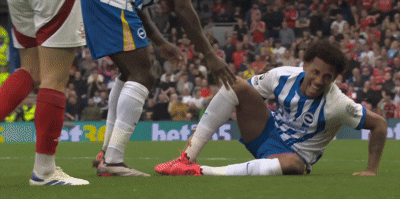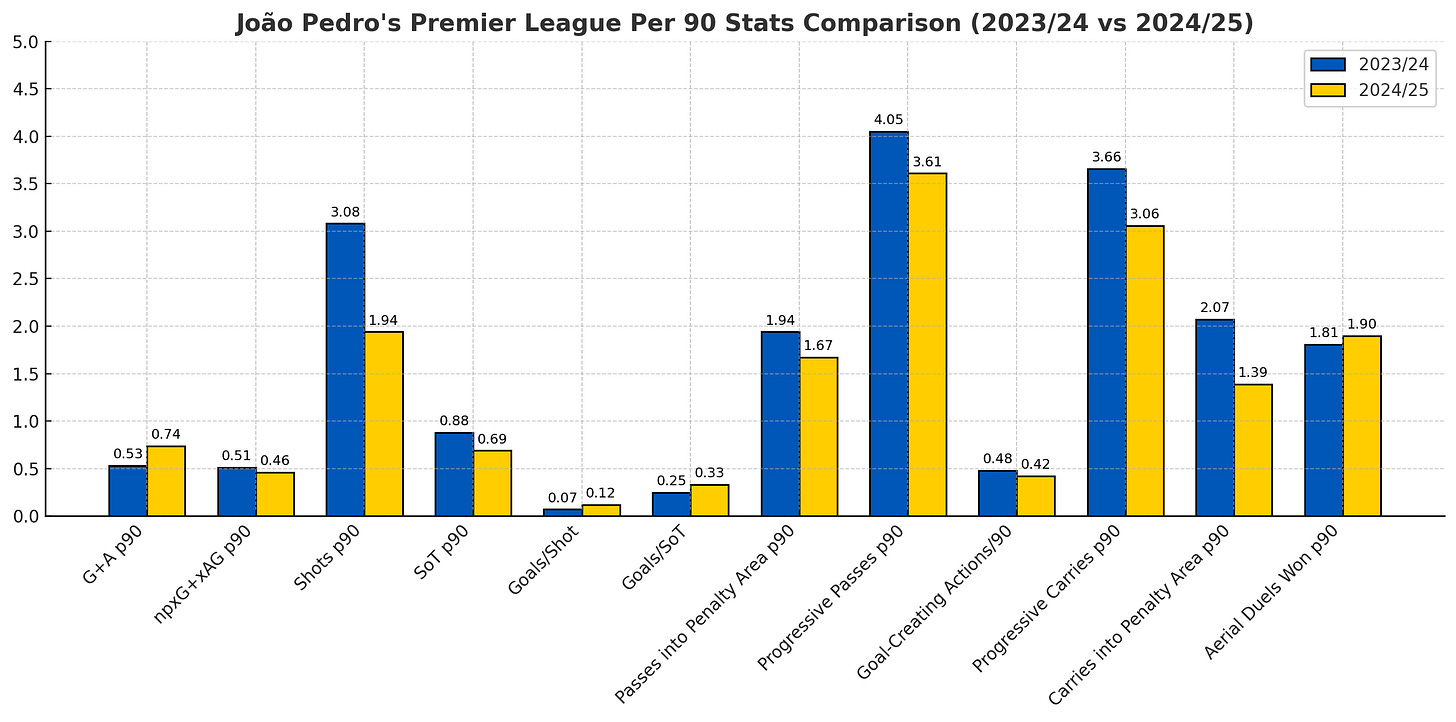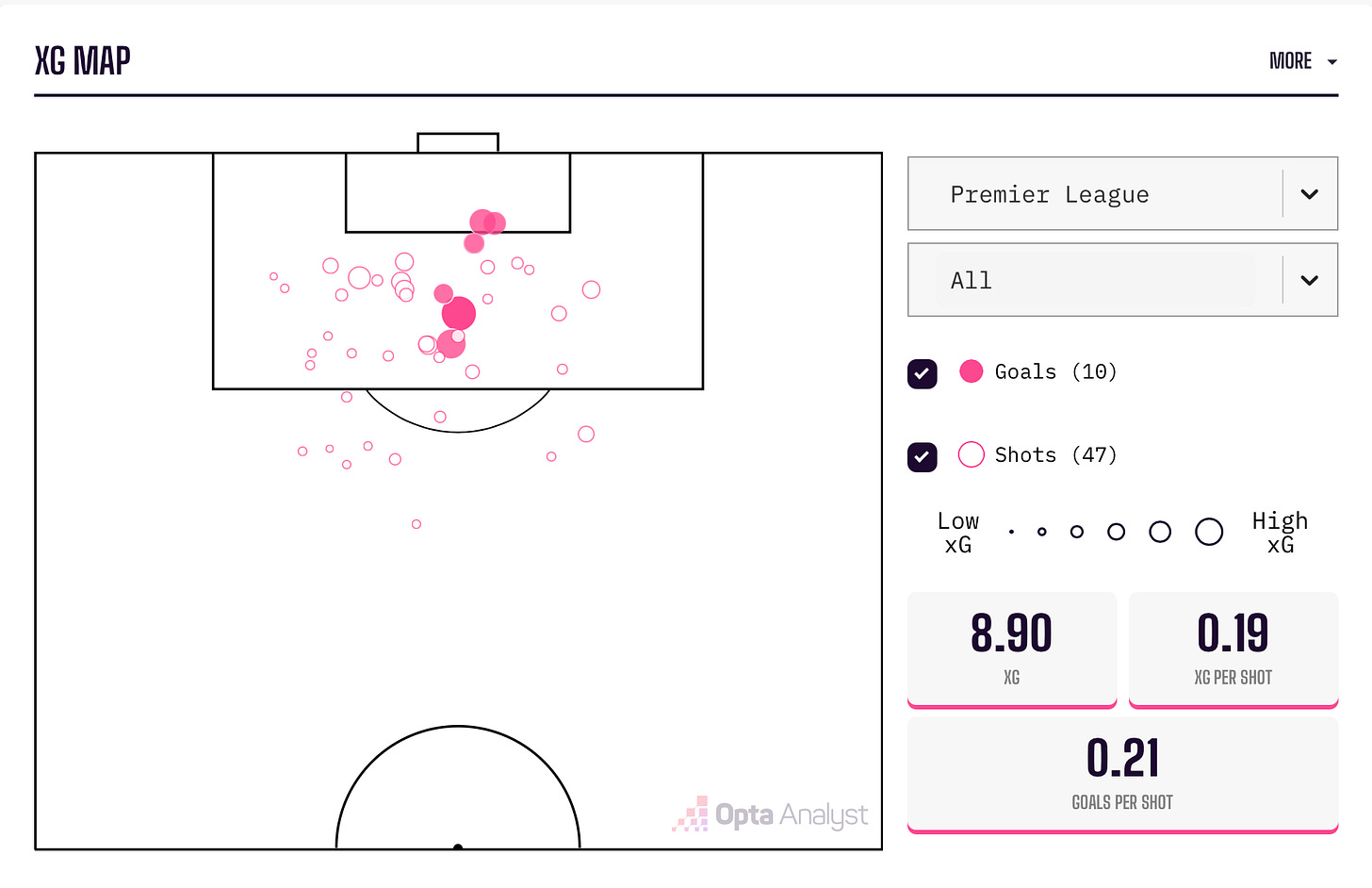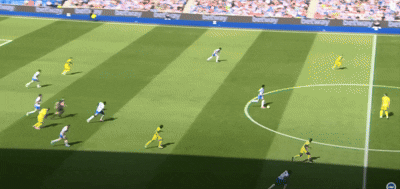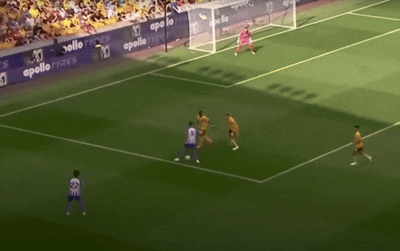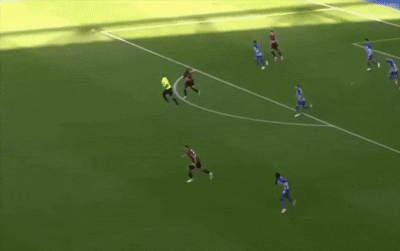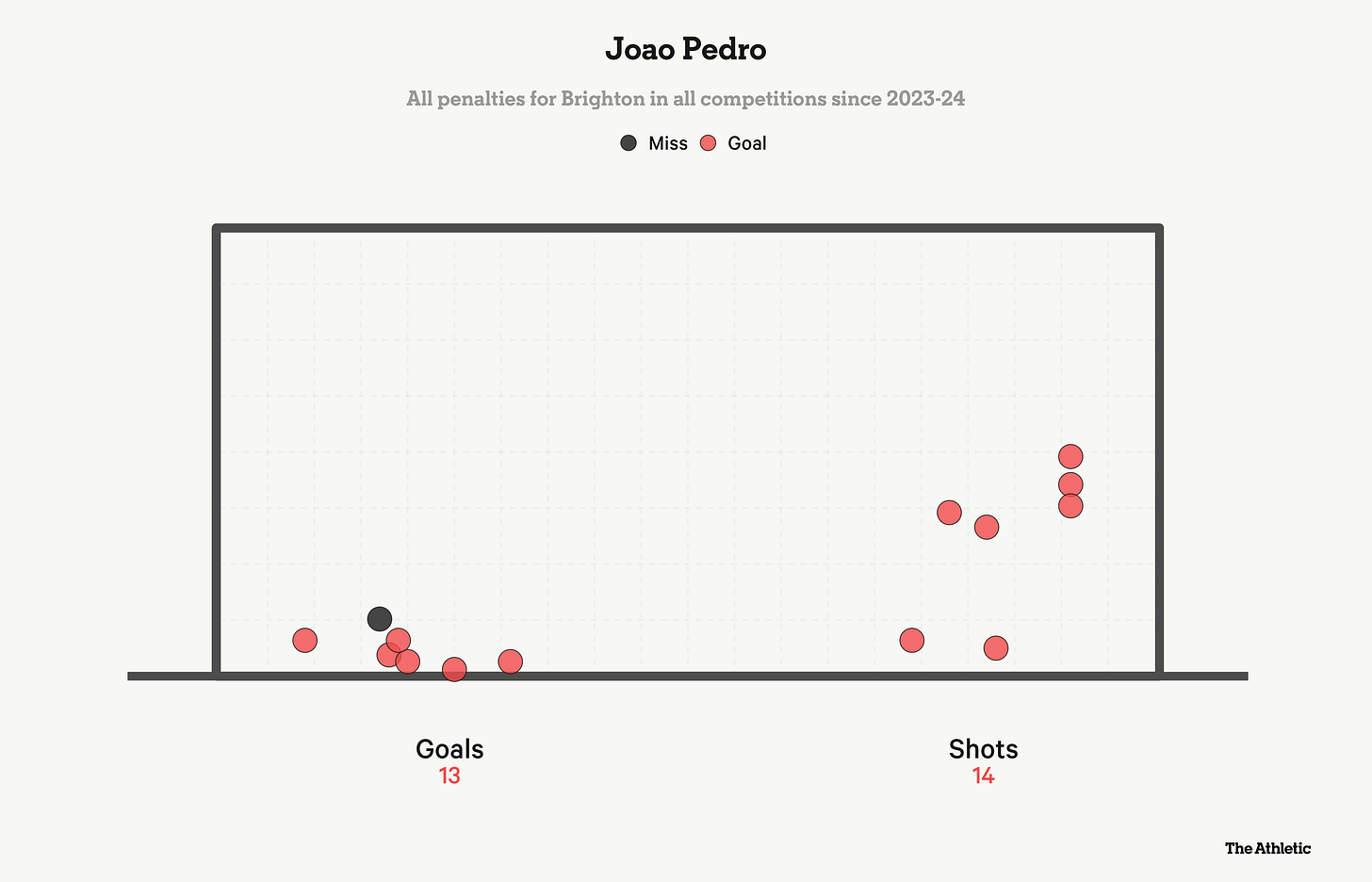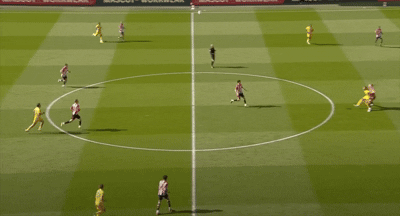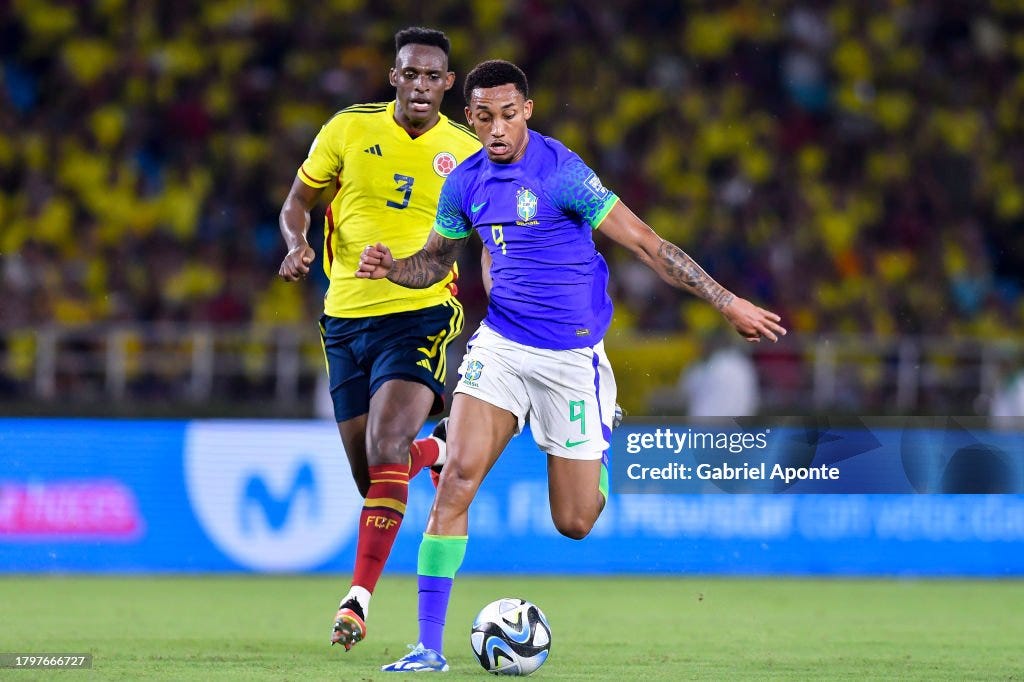Scouting João Pedro
Scouting report on a positionless footballer — ball-striking and early shots, movement and channel-running, link-up play and strength, work rate and aerial ability, scalability, and sports science.
Our story begins in 1984. On what was presumably a hot day in Kapsisiywa, Kenya, a child was born, just like any other. He would wake up every day and run three kilometres to school, never know who his father was, not meet a trainer of any kind until he was 16, and not win a major tournament until 2003.
He would eventually say:
I always tell people that this is a really simple deal: Work hard. If you work hard, follow what's required and set your priorities right, then you can really perform without taking shortcuts. If you're taking shortcuts, you can't be free.
Before going on to have one of the greatest careers his sport has ever seen.
Now, this isn’t the story of João Pedro—but rather, Eliud Kipchoge. Still, it sums up the essence of João Pedro rather well: a hard worker.
📚 Table of Contents
Chapter 1: Life and Fluminense
3.1 Finishing
3.2 Early Shots
3.3 Link-Up Play
3.4 Carrying and Dribbling
3.5 Work Rate
3.6 Back-to-Goal Play
3.7 Movement and Channel-Running
3.8 Heading
3.9 Penalties
3.10 Antics
Chapter 4: Conclusion and Scalability
Note for email readers: This email is truncated. To read the full article, please click on this link or the link to the right of [Message clipped] note at the bottom of this email.
🇧🇷 Chapter 1: Life and Fluminense
João was not even a year old. He would crawl around. He couldn’t even walk. He would grab onions, oranges, lemons. Anything that he would roll he would with play with.
At the age of four, João Pedro began playing football competitively.
At my grandmother’s house, I would take whatever there was. Paper for bottles, anything I could find just to play football.
At “soccer school,” he competed with older kids, and after scoring a brace in a Championship game, he was first noticed by a Fluminense scout. One week later, JP was integrated into Fluminense’s youth setup as a defensive midfielder, where he would go from from DM → AM → CF. In April 2019, under Fernando Diniz’s spinning wheel of relationshism, João Pedro made his league debut, scoring seven goals in his next four matches.
Diniz had this to say after JP’s hat-trick vs. Atlético Nacional:
A atuação foi iluminada, que acontece com os grandes jogadores de futebol. Estamos acostumados a ver isso com Messi, Cristiano Ronaldo... Então, não é uma coisa muito comum e tem de comemorar mesmo. É fruto de merecimento.
The performance was brilliant, something that happens with the great football players. We are used to seeing this with Messi, Cristiano Ronaldo… So, it's not something very common, and we really have to celebrate. It's the result of merit.
While evidently raw—and with most of his early highlights set to music that, thankfully, has been left behind in 2019—you could already see the fundamentals of a good striker in João Pedro’s game:
— The ability to leverage his arms to hold off defenders
— Quick twitches to run in behind and generate a decent leap
— A semi-strong core to support back-to-goal play
— Triggering shots quickly and with power inside the box
His steps were a little bulky, and he may have struggled against low blocks, but no matter—he was only 18. Plus, as Diniz alluded to, João Pedro was a hard worker:
Desde que cheguei, a maior competência que ele tem é a determinação e a maturidade que veio com precocidade.
Since I arrived, his greatest strength has been his determination and maturity that came at an early age.
🦌 Chapter 2: Watford
Muscular strength is not footballing strength. Bench pressing 225 pounds won’t help your hold-up play or let you bully defenders off the ball. João Pedro understood this:
As I’ve said, gaining the seven kilos was fundamental so that I have better stability on the pitch. Because if you look at the players here [England] they have strong physiques that help them perform on the pitch. Here in the Premier League and Championship, there is a lot of physical contact.
And it became crucial to his development. I mentioned that his back-to-goal play was already decent at Fluminense, but to play 2,757 minutes across 38 appearances—34 of which he started as Watford’s CF—at 19 years old, in the Championship? That takes some doing.
This was his first full season in England, starting as CF for a club with a history of developing quality forwards. He played full 90s regularly and didn’t miss a single league game due to injury. Not once.
João Pedro is a great kid. I speak to him almost every week. He's always asking what England is like and how I adapted here.
JP rotated between playing as a second striker in a 442 and as the lone CF in a 433. As the SS he had the freedom to drop deep (often cutting inside from the left) and make the most of his associative play. Within the 4-3-3, he attacked the ball from deep and frequently dropped between midfielders to help with progression.



JP finished as Watford’s second most prolific player (behind a certain Ismaïla Sarr), averaging 2.16 shots per 90 and 0.79 shots on target per 90. He scored both penalties he took (a topic I’ll return to later, as it’s very much JP’s USP) and was roughly middle-of-the-pack in pass completion across the squad.
His shot creation, however, stood out. He ranked fifth for passes leading to a shot, third in successful take-ons, second in fouls drawn, and first in defensive actions that led to a shot.
Defensively, he was relentless. He ranked fourth in actions in the middle third (as a CF, mind you), second in the attacking third, and placed in the top two for every defensive metric among Watford’s attackers.
Again—this was his first full season in England. At the ripe old age of 19.
All this means that his talent was immediately evident—and, more importantly, scalable. He showed:
— The ability to handle a heavy load
— Improved core strength to hold off centre-backs as a lone CF
— Intelligent movement to drop deep and progress the ball
— Tenacity and ruthlessness
— A nagging willingness to take on his man
Troy Deeney, Watford’s captain at the time, said:
He was exactly what you're seeing now... He's destined to go to the very, very top.
In 2021/22, Watford were back in the Premier League, and João Pedro struggled for consistent minutes and recorded just four goal contributions.
In other words: he wasn’t very good. But neither were Watford.
He regained some of his vigour in the Championship in 2022/23, recording 15 G+A in 35 appearances, despite a season hampered by injury.
Now, to be clear: constantly picking up injuries doesn’t automatically make you injury-prone. If a truck runs you over, that’s not on you—there’s only so much you can do. So, instead of dwelling on his time at Watford, let’s take a closer look at his injury record, because his ankle has (allegedly) become a small red flag over the past three years.
🍿 Intermission: Injuries
In October 2022, João Pedro missed three weeks due to a calf injury. Rob Edwards, Watford’s manager at the time, said (via The Athletic):
Yesterday we had to change the team in the morning. He felt his calf and he was doing it against Birmingham if you actually watch the game back there’s quite a lot of times when he’s limping.
He wasn’t fully confident on it. We had it scanned and it’s a minor tear on the calf. It won’t be too long but he was he wasn’t fit to play the game.
A common cause for this type of injury is muscular overload. Given how much football João Pedro played (and at such high intensity), the injury was entirely understandable. That said, if you don’t allow the tear to heal properly, reoccurrences become quite likely.
In December 2022, João Pedro was sidelined with an ankle injury following a slip after a tackle. He felt discomfort in his ankle, tried to play on with heavy strapping, but was eventually subbed off at half-time. Slaven Bilić, Watford’s manager at the time (because, of course, they’d sacked another one), said:
He's going to be out for about six to eight weeks. It's a big blow. None of the ligaments are completely ruptured, but they all have damage. I don't have to tell anybody what João means to this team. He's exceptional, he's someone you can build a team around and we will miss him.
Ultimately, this was an in-game incident and such things happen. There wasn’t much he could’ve done to prevent it, and as long as JP recovered well (which he seems to have), there’s no cause for concern.
Then in January 2024, JP would suffer a knee injury from a high-speed blow to the inner knee which likely caused a contusion. Once again, a contact injury and something beyond his control.
In February 2024, he suffered a hamstring injury that sidelined him for roughly 55 days. While unconfirmed, the injury was likely (also) caused by overload and muscle fatigue—understandable, really, given Brighton’s ongoing injury crisis at the time, which had significantly increased JPs pressing responsibilities.
In May, he picked up another ankle issue during training, which only sidelined him for one game. Details remain but a dream.
Then, in September, João Pedro returned from international duty with an undisclosed knock:
He made a training session today, and we shouldn't, or we don't want to [take] any risk for today. Let's see how the next days will be.
After missing a few games, JP came off the bench in Brighton’s 2–2 draw with Nottingham Forest, where he was clattered into by Morgan Gibbs-White. He hobbled through the remainder of the match, and although manager Fabian Hürzeler described him as a “good healer,” he remained sidelined. He missed another game and continued his recovery over the international break before returning to contention for Brighton’s clash with Manchester City in November—making this the most significant injury of his career to date.
Still, it was another contact injury—presumably a high or medial ankle strain—and was ultimately beyond JP’s control.
In January 2025, João Pedro twisted his ankle in training—presumably a lateral ankle sprain, with no ligament damage and/or lasting effects. A week later, Fabian Hürzeler had this to say:
He's training with the team and then we can decide if we'll take the risk to play him... What's most important is how the player feels. We won't do any stupid things; we have to wait until after the training session. We can't forget that he's still a very young player.
So, all in all, most of João Pedro’s injury troubles have been contact-related—something that shouldn’t be taken as a predictor of future issues (unless the injuries weren’t allowed to heal properly). His ankle may still require some caution, but there’s no major concern on the injury front, especially given how well his body has managed load so far.
🕊️ Chapter 3: Brighton
This part’s going to be a bit more free-flowing and rambly, because I vividly remember watching João Pedro over the past two years. So, let’s get the shallower, context-less numbers out of the way first:
👉 Finishing
To put this section in context: over his career, João Pedro takes his shots from an average distance of 15.7 metres from goal. Erling Haaland, by comparison, shoots 12.6 metres from goal. That difference is roughly 122 times the length of your phone. JP’s numbers are also skewed by the fact that he’s played substantial minutes as an AM—but even when deployed as a CF, he often drops deep into the LHS to help with ball progression (which I’ll touch on below).
Purely from a finishing standpoint, João Pedro is dependable (enough). He’s not the kind of player who’ll go on a hyper-clinical scoring streak, but when he hits a goal drought, it’s rarely (if ever) entirely on him.
Essentially, if JP gets the chance to score, he’ll (usually) take it. The real question is: how often does that chance actually come?
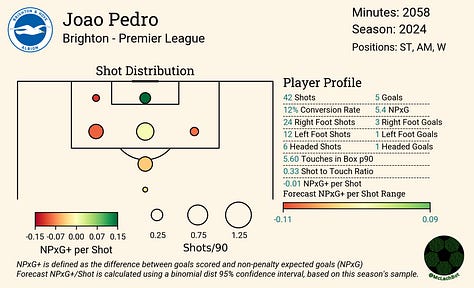
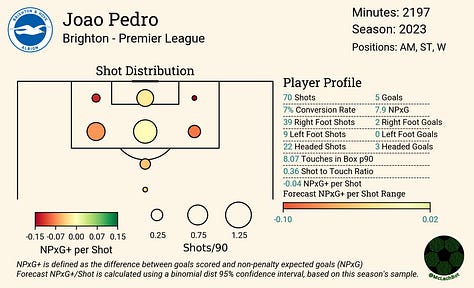

👉 Early Shots
I don’t think João Pedro has consistently gotten himself into good shooting positions this season even though the roles he’s played have suited him perfectly:
— A second striker, playing off the cuff, alongside a more traditional outlet-type like Danny Welbeck
— A striker bouncing off a shadow striker, like Georginio Rutter
But I don’t necessarily think this is a bad thing? Sure, it’s not ideal—but a recurring feature of Pedro’s game this season has been his tendency to drop deep into the LHS, receive the ball, lay it off to Mitoma/Ayari/Baleba, and then scramble up the pitch again.
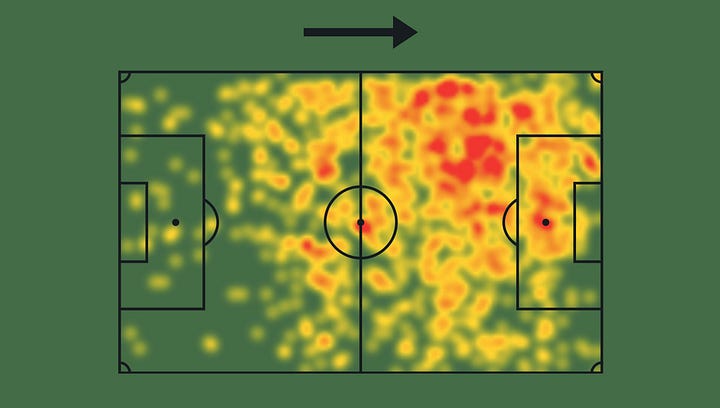

So yeah, a lot of his shots come from outside the box or from cutting in off the left.
What I will say, though, is that when João Pedro gets the chance to shoot, he takes it. He’s not afraid to shoot, watch it sail 20 yards wide of goal, and then shoot again. It’s the same mentality behind him dropping deep to progress the ball: he sees himself as Brighton’s focal point and is more than happy to take on that responsibility.
So, for someone playing off the striker, JP has done well to generate as many shots as he has. We’ve never really seen him deployed as a poacher-type CF, so there’s definitely some risk for teams that try to use him as one—but his shooting technique feels scalable. He anticipates passes well, beats his man consistently, and creates separation.
It’s also worth highlighting his shift-and-shoot ability. His spatial awareness in the box allows him to minimise the steps between his final touch and the actual shot—giving him both time and space to pick his spot, often aiming for finishing zones just beyond the goalkeeper’s reach.
Of course, we haven’t seen the full extent of his box-work at Brighton given the role he’s played this season—but even so, it’s already Champions League quality and easily translatable across any league in the world.
👉 Link-up Play
It’s difficult to judge João Pedro as a pure CF in this context. But if there are two moulds of CFs
— The big slab of meat who scores goals
— The wide-forward type who cuts inside to score
João Pedro is the latter. And he’s pretty effective at drawing in his teammates.
He’ll drop so deep at times you’d wonder why there’s a polar bear in Arlington, Texas—only to pop up near goal with quick passes and well-disguised curvilinear runs that drag CBs out of position, opening up space for Brighton’s wingers.
Playing as a DM during his academy days clearly helped develop his link-up play. I’d go as far as to say he’s one of the best in the Premier League at it: the type of player to single-handedly lift your team, carry them on his shoulders, and then crash the box looking to finish the move himself.
👉 Carrying and Dribbling
Let me start by saying João Pedro ranks first for miscontrols and second for dispossessions in Brighton’s squad. And weirdly, I think that’s a good thing.
It just goes to show he’s willing to take on his man.
He’s happy to dribble, happy to try things, happy to take risks to get the ball closer to goal. In fact, he ranks fourth in Brighton’s squad for attempted take-ons—and when you’re behind Mitoma and Minteh for a dribbling stat, you may as well throw your hands up and say, “Il n’y a rien que nous puissions faire.”
Plus his total shots per 90 aren’t too bad, especially when you consider how voluminous his progressive carries per 90 are.
It’s not like he’s immobile either, which adds an elusive quality to his carrying ability.
👉 Work rate
I opened this article with a video of Fabian Hürzeler applauding João Pedro’s work rate in an extra-time win over Newcastle, as well as a comparison to one of the greatest endurance athletes of all time.
But Roberto De Zerbi, at one point, publicly called him out for not working hard.
Later, he would say:
“The last step to become a great, great player is to play 90 minutes in the same way.
“Sometimes in the game he starts the game not at his best and I would like the beginning of the game until the end of the game to be the same mentality.”
Which led to:
And me—praying daily for JP’s hamstrings. He leads Brighton’s press regularly (as the LF in a 4-4-2) and won’t stop running until he physically has to, meaning his “floor” is already high thanks to his athleticism. You like Liam Delap? Then you understand the value of a workhorse like Conor Gallagher. And you’d love João Pedro.
👉 Back-to-Goal Play
João Pedro is strong—and deceptively so. He uses his body well, leveraging a stiff arm for balance and a stable centre of gravity, all while staying low and grounded through a solid core. He’s not easy to dispossess, and he’ll shield the ball like his life depends on it.
That’s true of any good striker. He wants the ball, he wants to shoot, and if he loses the ball, he wants it back.
👉 Movement and Channel-Running
This clip is from Roberto De Zerbi’s time at Brighton, so the system is very different from what we see today—slower, more robotic, more controlled. But just watch João Pedro (the eventual goalscorer) here:
João Pedro is quick, so when he has space, he’s happy to hang on the shoulder of a defender and wait for a ball in behind. This works especially well at Brighton, as Mitoma and Minteh are excellent at drawing out their markers and creating separation out wide which makes a searching pass from midfield into João Pedro’s feet a real possibility. Either way, this is a fundamental of attacking movement, and he attacks the space well here.
He then drops deeper as the ball shifts wide, drifting into open spaces (good players find space) that help him link play and overload the flank he’s operating on—typically the left. He’s comfortable receiving the ball to feet, creating separation, and carrying it forward-similar to what Mitoma does in the clip above.
When he’s in the box, JP does well to get into dangerous areas. In the clip above, Mitoma draws out his man, and João Pedro slips away from the CB marking him—opening up space to pounce on a rebound if a shot comes in. He spots the opportunity instantly, makes long strides toward the ball, and scores.
Beyond that, his movement to get to crosses is excellent, allowing him to connect cleanly with the ball and place it into the far corner.
Under Hürzeler, Brighton’s attack is rather fluid, and João Pedro is a floater. The freedom he gets shows just how well he reads the game—both with and without the ball—because he’s genuinely allowed to do what he wants and go where he wants.
Plus, he’s pretty great hanging off the halfway line when Brighton are defending deep in their box. He can flick a switch and move the ball quickly in transition, opening up to receive it, which cuts down the time he needs to turn while keeping his options wide open.
👉 Heading
Without being extraordinary, JP’s fairly decent in the air. He’s 182 cm (6’0”) tall, which is right about the sweet spot between someone who’s naturally good in the air and someone who really has to practice to become an aerial threat. I mean, if you’re 6’5”, you probably never had to put in the hard yards in your academy days by box-jumping—you’re tall, your head’s already in the clouds, and you might as well consider the NBA. But for a dogged, tall-but-not-too-tall, lanky João Pedro? He’s definitely had to work.
JP’s headed shots per 90 aren’t great simply because Brighton aren’t a cross-heavy team, instead relying on faster, dribbly wingers who want to score themselves (I don’t think you’d want to depend on Joël Veltman’s crosses from RB), which helps explain João Pedro’s limited aerial engagement.
That said, within Brighton’s squad, João Pedro ranks fifth for aerial duels won per 90—behind three CBs and a DM, all of whom are expected to dominate aerially. Plus, JP’s aerial duel success rate over the last three seasons sits at 54.07%, and when you compare this to Erling Haaland’s of 50.47%, JP’s doing pretty well for himself.
He also carries a surprising amount of momentum into heading the ball.
He’s definitely at—or close to—the level you’d want for a decent header in your squad (further raising his floor).
👉 Penalties
João Pedro has taken 19 penalties in his career and scored 18 of them. The one he missed, he made up for by scoring on the rebound.
I said when he joined the club, we were signing somebody very special, Murray tells The Athletic. As far as penalties are concerned, he is elite.
On the spot, everyone has their own individual styles, but when he is standing over the ball, he has a real clarity. Not only has he got confidence in himself, he has everyone’s confidence around him. He looks very comfortable.
It’s over a short spell, but you think of the likes of (Ruud) van Nistelrooy, Ivan Toney, Matt Le Tissier, Eric Cantona, he is probably not quite at that level yet, but I am sure over time his stats will stand up.
On four occasions, JP scored two penalties in the same game—against keepers who presumably studied his technique and had already faced one of his penalties in the same game. He also scored all four of his penalties in the Europa League, including one that sealed a draw against Marseille (A).
He has taken penalties in Europe in difficult moments and put them away, no problem, Murray says. They were 2-0 down at Marseille and to have the opportunity to rescue his side’s first-ever European venture in the 88th minute… that’s a lot of pressure.
So yes, he’s pretty good at penalties. It’s similar to Alexis Mac Allister, really—on his own merit, João Pedro should be the first-choice penalty taker wherever he goes. But this often comes down to the club’s internal dynamics, whether switching penalty takers would disrupt momentum, and so on and so forth.
Asked if he would choose anyone else to take a penalty after Joao Pedro’s 98th-minute spot kick snatched Saturday’s 2-1 home win against Fulham, team-mate Jan Paul van Hecke said: “I would put it all on him.” What about Salah? The Dutch central defender, who headed Brighton’s equaliser, added: “No. Joao Pedro at that moment for us is incredible.”
Now, I quite like penalty analysis, so a couple of things:
João Pedro practices penalties after every training session. The pros and cons of this can be debated:
— If you miss one, you start doubting yourself.
— There’s no real pressure, so to speak.
— But if it works, it works.
And it seems to be working for JP.
He has no clear preference between right and left, but when he shoots to the left, he tends to go low. That’s understandable—you’re going across your body, it’s harder to generate power from a standing start, and you don’t want to lose your balance, etc.
Ultimately, it’s this lack of a clear preference between left and right that plants seeds of doubt in goalkeepers’ minds. His tendency to go low isn’t necessarily a concern either—if you place it well enough, it really doesn’t matter. He’s shown he can do it against the best keepers and should continue to do so.
👉 Antics
There’s a sweet spot between gamesmanship and violence—a line João Pedro never really had issues with, until December 2024.
He is not The Undertaker; this is not the WWE. He wasn’t penalised for this action but was sent off a few months later against Brentford—the same opponent from the image above—for violent conduct, resulting in a three-game suspension.
Watching this clip back, I have my head in my hands. And so did Nathan Collins:
Now look, João Pedro’s incredibly competitive. If we assume sport reveals character rather than just shaping it, calling him anything but competitive feels unfair. People are complicated, and slapping harsh, singular, all-encompassing labels on him is just falling into preconceived biases. Defenders get leeway and preparation on how to handle attackers; attackers aren’t told how to clatter into defenders.
Essentially, mistakes happen.
But João Pedro seems like someone who can learn from mistakes. If his near-red card against Brentford didn’t teach him that, this incident should. Ultimately, I think he’s the kind of player who thrives on chaos and tries to rile up his opponents—but there’s a fine line, and one I believe he’ll be able to tread.
There’s also the matter of him not staying back to applaud fans after games, but there could be plenty of variables at play, and that veers into speculation, which is exactly the opposite of what you should do when judging someone’s character based solely on watching them in a hyper-competitive environment.
JP was then left out of Brighton’s squad for the games versus Liverpool and Spurs—the matches he was available for after his suspension—following a training ground altercation with Jan Paul van Hecke. Yes. The universally loved captain-in-waiting, Jan Paul van Hecke. And yes. João Pedro has captained Brighton before and is a part of the club’s leadership group.

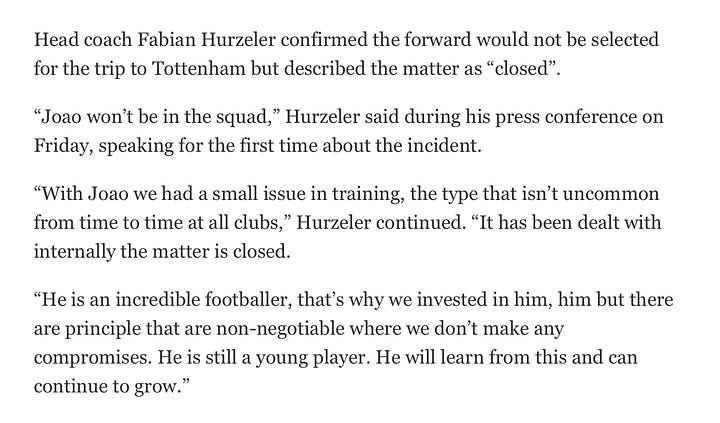
Jan Paul van Hecke made the squad for those games, and while Fabian Hürzeler said the matter had been dealt with internally and people were ready to move on, the fact that van Hecke made the squad seems to hint at who was “to blame.” But again, this is speculation territory, and until we know the full story, there’s not much more we can say.
So, as I say that mistakes happen and that JP can walk that sweet spot, he really needs to prove that he can. Until then, it’s tough to garner support from the fans and the media—even after what he’s given to the club.
🔮 Chapter 4: To Be Continued
In less cryptic terms, hello, this is the conclusion.
Every footballer at this level is immensely talented, and the gap between a 25th-percentile player and a 75th-percentile one isn’t as big as it seems. Worst case, I think João Pedro settles somewhere in that middle 50%—which is still a perfectly good outcome.
That said, what sets him apart is his athletic floor and mental profile. His willingness and tenacity mean you’re guaranteed a baseline level of performance every week. Even if he goes missing in possession—stops shooting, scoring, or literally forgets how to pass (which won’t happen because JP is extremely technical)—he’ll still run, still press and still disrupt the build-ups everywhere. And that, whether directly or indirectly, will lift his teammates.
Best case? He becomes a world-beater and, somehow—someHOW—ends up as Brazil’s starting 9 or 10.
That reminds me: Brazil’s now ex-manager, Dorival Júnior, had this to say about João Pedro when he was called up:
He has an interesting profile, he floats and projects, he has a considerable number of goals. He has already played that (No 9) role. I want movement, mobility, without too much positioning.
And I think that sums him up perfectly. JP is a 9.5. JP is Cunha (sort of), but better. For the purpose of this article, I’ve analysed him as a CF, since that’s likely where most teams looking to buy him would use him, but if you're signing JP with the intention of playing him as more of a 9.5-type, I’d say his floor is around the 60th percentile—making this, in isolation, about as low-risk a purchase as you can get.
The next question you can raise about João Pedro is how shouldering less responsibility will weigh on him. Fabian Hürzeler empowers JP and lets him do what he wants. Eddie Howe would do that too (because Eddie Howe is a world-class manager). Enzo Maresca would not.
Where I think this should raise more questions about the manager than the player, I also think forcing JP into an autonomous system would sort of… ruin him? He thrives with the freedom to float, and that’s simply because of how well he understands space. He’s relatively safe in possession, and he’ll do everything you need to get the ball into the box and try to get on the end of shots.
He’ll survive in an autonomous system, but you really would miss out on a lot of his qualities if you shove him into one (so please, do not).
Is he Champions League ready? If he gets consistent minutes next season (let’s say split between playing as a 9 and a 10), I think he can hit 15 goals in the (Premier) League. That’s a big jump from what he’s already managed—but yes, I do think a lot of João Pedro’s game is UCL-ready.
The work rate is already there. The speed to shift and shoot is there. His ability to use his body to shield the ball is there. And I’d argue the mentality is… getting there.
I’ve spoken about his so-called antics, and there really isn’t much else to say. There’s a fine line he can’t cross—but that’s on him to figure out.
But until then, this is a world-class player waiting in the wings (well—at CF, ha). Watford and Newcastle know how to spot a good striker, and they both want(ed) João Pedro. The smartest footballing brains know there’s just something about him—and there most definitely is.
🎥 Credits
Thank you for reading. I hope you’ve enjoyed this piece. To see similar pieces, please consider subscribing so my posts can reach your inbox, tailored to your convenience.
For psychology, economics, and the occasional musing, please considering checking out instinctively.substack.com (creative name, I know).
Here are the sources referenced in this article. All credit to the respective owners, and thank you for the outstanding work you do
McLachApp, FBref, Sofascore, Opta Analyst, The Argus, The Athletic
Thank you, and have a great day.















